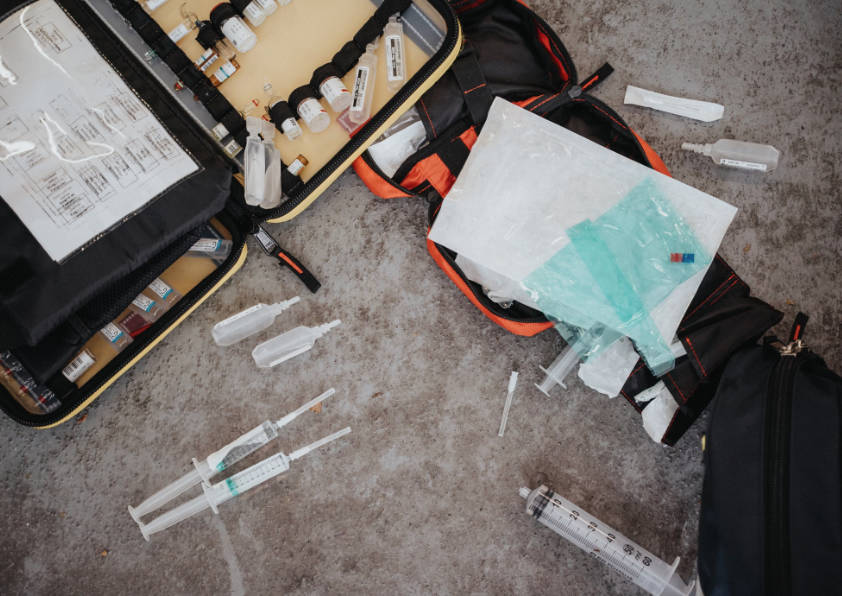In modern healthcare, medical plastics are a fact of life. In fact, they’re a matter of life and death. They play a crucial role in the safety, efficacy, and accessibility of medical treatments and procedures. From life-saving devices made with medical-grade plastic, to sterile packaging – medical plastics have revolutionised healthcare and patient outcomes. Not just here, but around the world.
In a life or death situation, plastic can make all the difference. Nobody wants to think about the alternative; losing their life for the sake of a “green” solution.
But concerns about plastic pollution persist. We can’t ignore it. Medical plastics might well be irreplaceable, with no alternatives available – possibly ever. So, in this article, we ask; how can we strike a balance between our dependence on these materials, and limit their environmental impact?

Medical plastics: a fact of life
Using medical plastics has been a recurring topic in our discussions about healthcare and environmental sustainability. As we know, plastics have significantly contributed to advancements in medical tech – enabling the creation of intricate devices, implants and diagnostic tools.
Read more: Saving Lives With Medical-Grade Polythene
Plastic medical packaging also keeps medical equipment safe until the point of use, by providing a sterile barrier that prevents contamination. But the paradox lies in the fact that, while medical plastics offer life-improving solutions, they also contribute to the broader issue of plastic pollution. And this is compounded by the fact that there aren’t really any alternatives to medical plastic.
No viable alternatives
Critics propose alternatives like glass containers for medications, or biodegradable materials for single-use medical tools. But this is a simplistic and blinkered view of the reality of modern healthcare – and these suggestions often overlook practicality and safety concerns. Glass jars can be heavy, breakable and may not be suitable for all types of medications.
And while biodegradable materials might sound good, they are prone to decay – and might not maintain the required levels of sterility or durability needed in medical settings. Plus, as we’ve covered previously, the self-proclaimed eco-friendly world of bioplastics is more of a minefield than we’ve been led to believe…
We Don’t Sell Biodegradable Polythene Bags. Here’s Why.
What about paper and card? They’re not sterile, they’re not waterproof – they’re not even good for the environment. Finding alternatives that meet the rigorous demands of healthcare, without compromising patient care is a complex task, and one that may not arise without a major, fundamental shift in the way we value materials and production.
So what could overtake plastic in medicine?
The challenge of plastic-free medical care
Medical devices and drugs can take up to a decade to develop and gain approval for use – and this doesn’t even factor in the research and development, or the design. Safety is the priority, and any new material will have to undergo a rigorous testing process to ensure safety.
Transitioning away from medical plastics is not only a financial challenge, but a potential risk to patient health and safety. The true cost is human and environmental, and whatever the materials we choose to reduce our dependence on plastics with, we’ll likely be met with a similar balancing act between cost, safety and sustainability.
The balancing act – sustainable practices
The quest to reduce the environmental impact of medical plastics is going to be a journey that everyone takes. Researchers, healthcare professionals, and manufacturers are actively seeking innovative ways to reduce plastic usage, while maintaining medical standards. Patient expectations also need to be managed, and there needs to be education around where our medical plastics come from – and where they go.
Developing recyclable plastics, optimising packaging efficiency and implementing proper disposal and recycling protocols is a challenge that we’ve discussed before; the so-called “ick factor” of reusing medical plastic is hard to overcome, but it’s important to note that not all medical plastic comes into contact with patients, and can easily be recycled. It’s just got a stigma attached to it, because of where it came from.
Raising awareness among both medical practitioners and patients about the importance of responsible plastic use can contribute to more sustainable practices – but what about new materials?
Medical packaging innovations
There’s a push to plant-based packaging – be it resin and oil-based, or fibre-based. But let’s not beat around the bush; these are essentially plastics and papers, by another name. Bamboo, hemp – whatever the material, they need water, time and land to grow, and create the same level of waste – it’s just kicked down the road (or rather, into a different postcode).
Waste is waste, no matter what product is left behind. Eliminating waste is probably impossible. But our mission should be to reduce it to the bare minimum – to reuse, recycle, and remake using what we have available.
In medicine, the challenge is doing this without compromising safety. And in a healthcare system already stretched by an ageing population and workers leaving in their droves, that challenge is all the more difficult.
So, what can we do? The answer may forever be out of reach.
Medical-grade polythene packaging
Our packaging design experts design custom medical polythene bags for use in critical applications. Get a custom polymer blend in practically any colour, with our custom printing process for absolute clarity. Ready to order? Get a quote online, or call us on 01773 820415.


